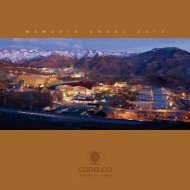You also want an ePaper? Increase the reach of your titles
YUMPU automatically turns print PDFs into web optimized ePapers that Google loves.
eportaje / news report<br />
Foto / Photo: José Salinas – LATINOMINERÍA<br />
tivo meteorológico y la medición de las<br />
vibraciones de las tronaduras.<br />
El sistema predictivo meteorológico<br />
estima previamente las emisiones de<br />
material particulado de las tronaduras,<br />
para minimizar su impacto en la comunidad.<br />
El plan de humectación consiste<br />
en regar las zonas antes de una perforación<br />
y después de efectuada una<br />
tronadura, de manera que cuando se<br />
saca el material con palas, se abate la<br />
emisión de polvo.<br />
En lo que es la relación con la población<br />
y el cuidado del entorno, la<br />
Corporación estableció el Proyecto Estructural<br />
de Medio Ambiente y Comunidades<br />
(Pemac), el cual se materializa<br />
en DMH incorporando las mejoras<br />
prácticas y de relacionamiento con la<br />
comunidad que existen en la industria<br />
minera. Esta estrategia se estructura<br />
en la División en cinco ejes de trabajo:<br />
inversión social; educación y cultura;<br />
generación de riqueza e ingresos; creación<br />
de empleo y habilidades; y participación<br />
activa de la comunidad.<br />
El área de inversión social tiene que<br />
ver con iniciativas de infraestructura<br />
básica, mientras que en educación y<br />
cultura destaca el proyecto de Escuela<br />
Sustentable, que lleva a cabo actividades<br />
para que establecimientos de<br />
educación primaria se certifiquen ambientalmente<br />
y generen proyectos que<br />
permitan generar una cultura ambiental<br />
desde la primera infancia.<br />
En el área de generación de riqueza<br />
e ingresos se apoyan emprendimientos<br />
para la gente y en el área de creación de<br />
empleos y habilidades se trabaja en su<br />
capacitación. Otro trabajo innovador es<br />
lo que se está haciendo para potenciar<br />
la participación activa de la ciudadanía,<br />
donde destaca la formación de los llamados<br />
“seguidores ambientales”, vecinos<br />
de la mina que son preparados en cursos<br />
para que puedan fiscalizar ambientalmente<br />
la operación de Ministro Hales y<br />
Claudio Olguín, gerente general de División<br />
Ministro Hales.<br />
Claudio Olguín, general manager of División<br />
Ministro Hales.<br />
Foto / Photo: Ricardo Jeria – LATINOMINERÍA<br />
Hales. Modifications were also made<br />
to allow the Teniente Convertor 2 at<br />
Chuqui to receive calcine while the capacity<br />
of the refinery to handle and<br />
treat anode slimes was increased.<br />
The plants at Ministro Hales are<br />
divided into three large areas. The first<br />
is the crushing area, home to the primary<br />
crusher, the overland conveyor<br />
and the 50,000 ton–capacity stockpile.<br />
The second is the concentrate<br />
area, which includes a SAG mill, two<br />
ball mills, floatation cells, the tailings<br />
thickeners, concentrate thickeners and<br />
the filtration plant. Finally there is the<br />
roasting complex, which consists of<br />
the concentrate dome (where output<br />
from the concentrator plant is stored),<br />
the roasting plant, the electrolytic precipitators<br />
(to treat emissions from the<br />
roaster plant) and the acid plant.<br />
The primary crusher is a 60" x<br />
89" ThyssenKrupp unit while the 36'<br />
SAG mill was produced FLSmidth and<br />
equipped with an ABB motor. The<br />
screens were produced by Ludowici<br />
and the 260 cubic meter primary floatation<br />
cells and the regrinding mills<br />
were supplied by Metso as were the<br />
first and second rougher floatation<br />
cells and the concentrate thickeners.<br />
The tailings thickeners are produced<br />
by Delkor while most of the equipment<br />
in the roasting complex was<br />
produced by Outotec.<br />
The roasting plant at Ministro<br />
Hales is the only one of its sort in Chile.<br />
“This is a fluid bed roaster which<br />
treats the concentrates produced<br />
by the concentrator plant”, says the<br />
plant’s manager roberto Stocker. “in<br />
the first stage, the concentrate from<br />
the concentrate thickeners is filtered<br />
to remove the water and is stored in<br />
the dome. The concentrate, with a<br />
humidity of 8%, is fed into the roaster<br />
which is an air–injected and fluid bed<br />
reactor. The concentrator is bubbled<br />
at a temperature of 700ºC, causing<br />
it to decompose. As it decomposes,<br />
the impurities are liberated and the<br />
final product is a copper–rich calcine”.<br />
This calcine is trucked to Chuquicamata<br />
while the sulfuric acid is captured<br />
and stored in tanks before being<br />
sold to third parties.<br />
susTainabLe operaTion<br />
Ministro Hales has also sought to<br />
encourage a new sustainable culture,<br />
which has been applied since the<br />
start of construction. The pre–strip-<br />
marzo–abril / march–april 2014 l Latinominería l 21



